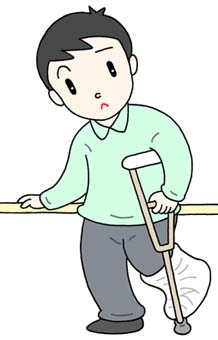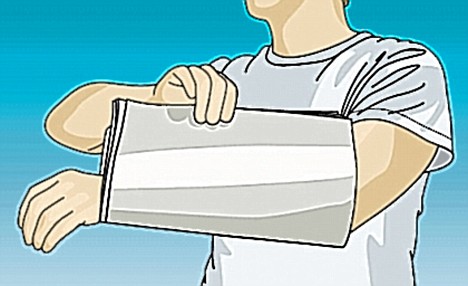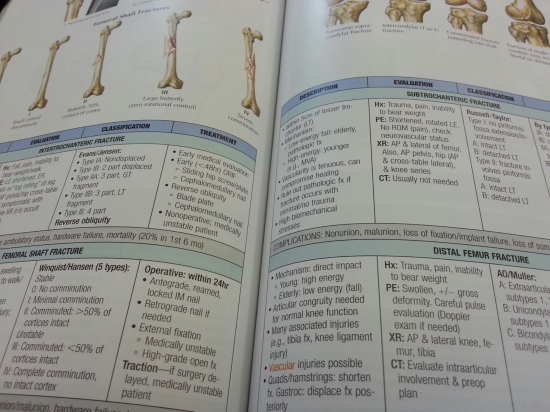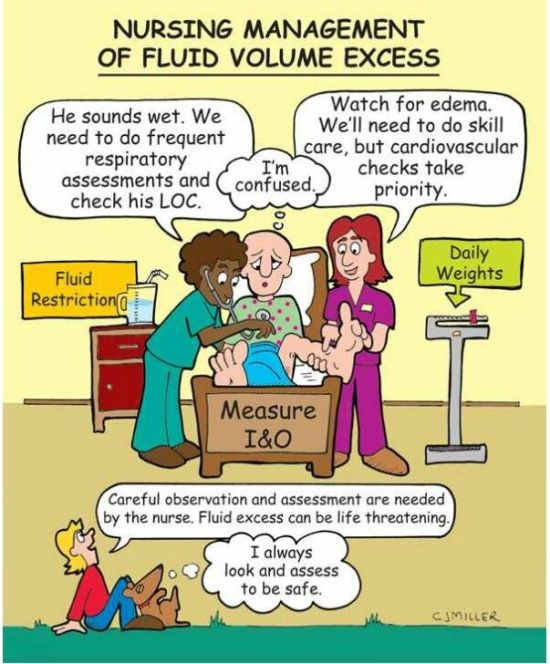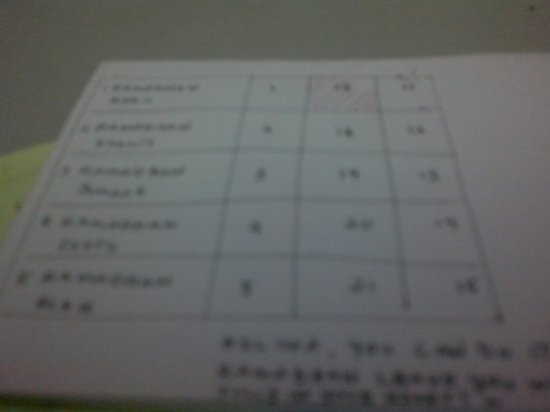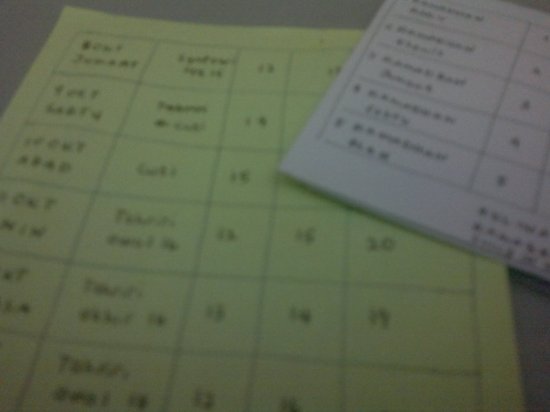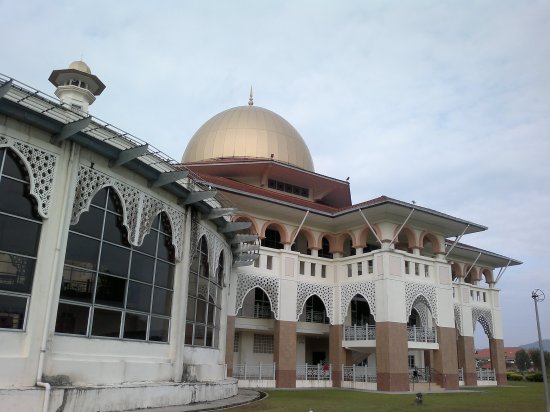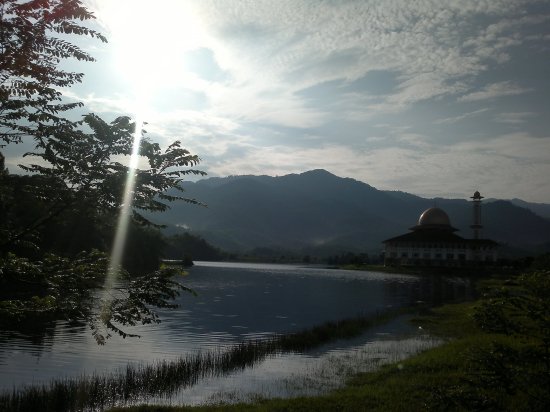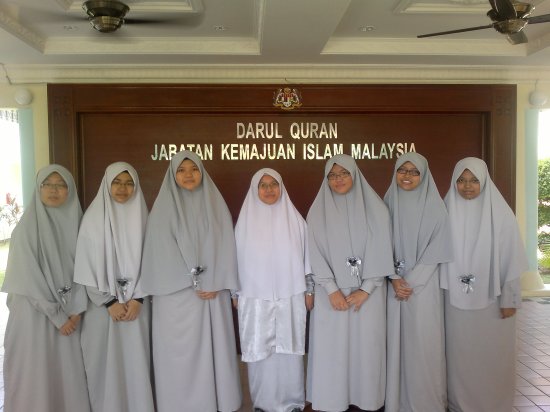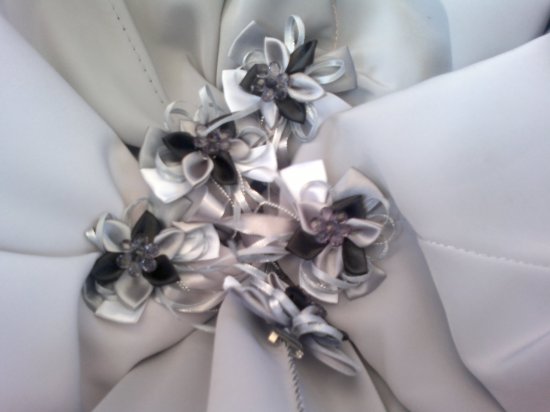Fractures at the Tibia and Fibula
November 26, 2015 at 11:35 pm | Posted in Uncategorized | Leave a commentP/s: As usual, I did not owe this note. Credit should be given to Appley and Netter’s Concise Orthopaedic and of course my lecturers 😉
1. Patella #
Most important is to look at the extensor mechanism, is it intact or not.
Extensor mechanism comprises of:
➡ Quadriceps
➡ Patella
➡ Patella tendon
How to test?
Ask the patient to lift up the leg.
MOI
1. Direct injury to patella. Usually result in undisplaced and comminuted fracture (stellate #). Extensor mechanism usually intact.
2. Avulsion #. Sudden forceful contraction of the extensors. Usually result in displace transverse # with involvement of the extensor mechanism.
Management:
Huge hemarthrosis
➡ requires aspiration as it can damage the articular surface, however this may cause it to become an open #.
➡ aspiration is done using an aseptic technique, hence no need to treat as open #.
➡ small hemarthrosis usually resolves spontaneously
Definitive Management
🔴 Undisplaced # – knee brace/casting for 6 weeks + exercise to prevent joint stiffness.
🔴 Comminuted, displaced, with intact extensor mechanism – partial or full patellectomy.
🔴 Displaced with involvement of extensor mechanism – ORIF (tension bands wire) and repair of extensor mechanism.
Complications:
Patellofemoral OA
Decreased ROM
2. Patella Dislocation
MOI:
Direct force to patella – rare.
Sudden forceful contraction of the extensors muscle – more common MOI esp in sports
Clinical features:
Usually patella has reduced spontaneously or else, obvious deformity.
Bruises and swelling.
Fluid aspiration, may contain blood. If contain fat meaning that there is osteochondral #.
Management:
💟 Closed reduction. Usually did not need anaesthesia.
After that, put in braces for 2-3 weeks followed by 2-3 months exercise of the extensors.
💟 Intraarticular dislocation usually need operative treatment.
💟 Severe bruising indicates severe soft tissue injury. It requires surgical exploration and repoir of the damaged structures.
Complications:
Recurrent dislocation
♠Recurrent Dislocation♠
2x in a year.
It may follows patella dislocation or can be due to other factors such as ligamentous laxity, underdeveloped femoral condyle or underdeveloped patella.
Dislocation occurs unexpectedly when the quadriceps muscle is contracted with the knee in flexion. Painful.
Dislocation usually reduce spontaneously.
Positive apprehension test – patient worried that dislocation happened again.
♣ Habitual Dislocation ♣
Dislocates even with sitting to standing position. It is painless.
Long term, patella may permanently dislocate.
3. Tibial Spine #
MOI:
Varus or valgus stress, or twisting injury damage the ligamentsband caused # of the tibial spine.
Usually in paeds and is a traction injury.
Management:
Close reduction under anaesthesia.
If failed, OR & IF (screw)
Post reduction, casting for 6 weeks.
4. Tibial Plateau #
MOI:
Varus or valgus force combined with axial loading (intact femoral condyle hit the tibial plateau).
It will result in tibial plateau fracture, meniscus injury, with/without ligament tear.
Classification:
Schatzker
Type 1 ➡ lateral plateau #
Type 2 ➡ lateral plateau # with depression #
Type 3 ➡ depression #
Type 4 ➡ medial plateau #
Type 5 ➡ bicondylar plateau #
Type 6 ➡ # with metaphyseal and diaphyseal seperation
CT scan will visualize the # clearer.
Management:
🔘 Aspirate the hemarthrosis
🔘 Undisplaced ➡ casting for 6-8 weeks. NWB until # unites
🔘 Displaced ➡ IF (Buttress plating)
🔘 Depression # (type 2&3) ➡ Bone graft/rafting using screws
🔘 Severe swelling ➡ use ex-fix to stabalize until swelling subsides before IF
🔘 Ligamentotaxis ➡ using traction to achieve close reduction.
🔘 Old and frail ➡ conservative mx
🔱 later ligaments and meniscus repair
Complications:
1. Compartment syndrome (esp Type 4 onwards due to severe bleeding)
2. Joint stiffness (multiple op and prolonged immobilization)
3. OA
4. Popliteal artery injury
5. Common peroneal nerve or tibial nerve injury.
6. Deformity
5. # of Tibia and Fibula
MOI:
Twisting force ➡ spiral #
Angulatory force ➡ transverse or oblique #
Low energy usually caused by indirect injury.
High energy may cause open # and comminution.
Why open #?
Tibia is located very superficial.
Hence, evaluation of surrounding soft tissue is very important.
Risk of non-union is high due to poor blood supply.
Risk of compartment syndrome is also high owing to the presence of a lot of compartments in a small space.
Management
🌞 Tibia/fibula # less than 7 cm from ankle joint, treat as intraarticular #, hence need anatomical reduction.
🌞 Undisplaced # ➡ casting for about 8 weeks.
Start with above knee POP, when # unite can gradually change to below knee POP.
🌞 Displaced ➡ close reduction followed by casting.
Few precautions:
1. Angulation allowed for AP is only up to 5°. Why? May predispose to secondary OA of knee joint due to unequal force exerted to the knee joint.
For lateral, up to 15°. Why? Because it is in the axis of movement.
2. Reduced # may displaced back ofter reduction once swelling subsides➡ need to check the x-ray frequently.
3. Compartment syndrome.
That is why tibial # seldom treated close in adult.
🌞 The best choice of IF will be ILN.
🌞 Plating still indicated in metaphysial tibial # where nailing is difficult.
🌞 Unstable # (high comminution or segmental # need early stabalization)
Complications:
1. Malunion
2. Delayed/non-union
3. Compartment syndrome
4. Osteoporosis (distal part. To avoid, allow early weight bearing)
5. Joint stiffness due to prolong immobilization
6. Vascular injury ➡ popliteal vessels
Fracture of the tibia alone
🔶 Low energy trauma
🔶 Reduction is harder due to intact fibula
🔶 Rate of non-union is higher also due to intact fibula.
🔶 Otherwise, management remain the same.
6. Fracture of the Malleoli
MOI:
Low energy injury, usually due to twisting force (ankle goes into inversion)
Classification:
Denis-Weber classification (Classify according to fibular # in relation to the syndesmotic joint)
✳ A: Transverse fibular # below the syndesmotic joint.
MOI: Adduction injury.
Usually results in oblique or vertical # of medial malleolus.
✳ B: Oblique fibular # at the syndesmotic joint.
Usually result in deltoid ligament and anterior tibiofibular ligament injury.
MOI: External rotation injury.
✳ C: Fibular # above syndesmotic joint ➡ part if the syndesmotic joint and tibiofibular ligament are torn.
MOI: Abduction injury
Associated injury: Avulsion # of the medial malleolus, a posterior malleolar # and diastasis of the tibiofibular joint.
Other classification is Lauge Hansen. Classification is based on MOI and foot position.
Intraarticular injuries❗
Hence need perfect reduction.
Post CR, check X-ray needed. Must meet 4 criterias:
1. Normal length of fibula restored.
2. Thalus sit squarely on the mortise.
3. Normal width of medial joint line.
4. No tibiofibular diastasis
# often unstable, hence frequent checking of the x-ray.
Management:
Dislocated joint ➡ need to reduce immediately.
Check X-ray.
Undisplaced joint ➡ Casting for 4-6 weeks.
Except:
🔵 Type B if involve the tibiofibular ligament
🔵 Type C often unstable. Hence better fix earlier.
Unstable/Displaced # ➡ ORIF. Aim for restoration of fibular length. Add syndesmosis fixation if unstable syndesmosis
7. Pilon Fracture
MOI:
High energy axial loading. Fall from height.
Thalus drives upwards towards the tibial plafond.
Slow to heal.
Injury:
1. Comminuted # of the metaphysis of tibia.
2. Severe soft tissue injury ➡ # blisters. This may lead to complication (soft tissue cannot tolerate, predispose to wound breakdown and infection) with early open treatment.
3. Seperation of malleoli and fibula #
4. Compression of articular surface of tibia.
Classification (Reudi/Allgower)
Type 1 ➡ non or minimally displaced
Type 2 ➡ displaced, articular surface incongruous
Type 3 ➡ comminuted articular surface
CT needed to clearly visualize # site.
Management (staged treatment)
1. Elevate the ankle & put ex-fix to hold the # until swelling subsides.
2. May plan IF. Usually ORIF (plating KIV bone graft)
However, severe injury might need indirect reduction using legamentotaxis.
3. Post fixation, elevation and early mobilization reduce edema.
Complications
1. Joint stiffness
2. Secondary OA (degree of cartilage injury plays and important role)
Fractures of the Upper Limb
November 26, 2015 at 2:05 pm | Posted in Life as a Medical Student, Notes | Leave a commentTags: humerus, orthopedic notes, radius, ulnar, Upper limb fractures
P/s: As usual, I did not owe this note. Credit should be given to Appley and Netter’s Concise Orthopaedic and of course my lecturers 😉
1. Proximal humerus # in adult (elderly and osteoporotic)
Management depends on parts. (Neer Classification – head, GT, LT, shaft)
🔵 Undisplaced/minimally displaced: sling
🔵 2 fragments: closed reduction & splint.
🔵 3 fragments: operative
🔵 4 fragments: ORIF in young, may consider hemiarthroplasty in elderly.
Complications:
Shoulder stiffness
Brachial plexus injury
AVN (Anatomical neck #)
Nonunion
2. Shaft #
🐛Management:
Usually treated close (CMR + casting) as humerus heal readily. Complications following operative management higher.
ORIF (either plating/nailing) is still indicated in open #, severe comminuted #, polytrauma, unstable #.
🐛Humerus can accept more angulation due to presence of both elbow and shoulder joints.
Can accept up to <3cm shortening <20°AP angulation and <40° lateral angulation.
🐛Complications:
Distal 3rd #, radial nerve palsy, however mostly are neuropraxia. Why? Radial nerve in spiral groove, can become trapped easily.
3. Distal Humerus #
🐞In adults, mostly intraarticular, either bicondylar or unicondylar.
Extraarticular (supracondylar) but very rare.
🐞Management, as usual:
Undisplaced, treated close.
Displaced, need anatomical reduction, hence ORIF.
🐞Complications:
1. Ulnar nerve palsy. (Ulnar is situated posterior to medial epicondyle).
2. Median nerve palsy. (enters forearm at biceps aponeurosis)
3. Elbow stiffness
4. HO
4. Supracondylar # in children
:idea:Most common, extension type (posterior displacement), Gartland classification.
:idea:X ray: Fat pad sign. Fat pad at coronoid and olecranon fossa is displaced.
:idea:Management:
Gartland 1: casting
Gartland 2 & 3: CMR and k wire.
Children has good remodelling and thick cortex. K wire itself sufficent.
Rarely need ORIF. Still indicated for unreduced #, vascular involvement.
:idea:Complications:
1. Nerves injury
– Radial (between brachialis and BR @ posterior elbow)
– Median (jaggered fragments poke the median nerve/AIN)
– Ulnar
2. Vascular injury – brachial artery (same mechanism as median nerve injury)
3. Malunion – cubitus varus. Usually due to angulation.
5. Elbow dislocation
🌼Simple or Complex (with fractures of the surrounding structures). Posterior dislocation commonest.
🌼Terrible triad: Dislocation with radial head & coronoid #.
🌼Tx.
Simple – simply by closed reduction, then splint (collar and cuff for 1 week, start exercise after that, off by 3rd week)
Complex – settle the # first.
🌼Complications:
1. Nerve injury.
-Ulnar nerve (in cubital tunnel)
-Median nerve in Ligament of Struthers)
Both can become compressed
2. Vascular injury – Brachial artery
3. Elbow stiffness and instability.
➡ Recurrent dislocation very rare
6. Fractures of the Radius and Ulnar
Manage like an intraarticular #, needs anatomical reduction. Why? Presence of supinator and pronator muscle. Not easy to maintain reduction.
👉Both bone #
Paeds, closed reduction and casting. Remodelling is very good.
Adult, ORIF (plating)
👉Single bone #
Monteggia: Prox ulnar # with PRUJ disruption (radial head dislocation due to shortening force @ ulnar)
Mx: ORIF. Dislocation will reduce when # has been managed
Galleazi: Distal 1/3 radial # with DRUJ disruption
Mx: ORIF, DRUJ closed reduction.
7. Distal End Radius #
MOI: Axial force, FOOSH
Common, esp in osteoporotic pt.
✴ Colles #, dinner fork deformity ( dorsal displacement)
✴ Smith #, reverse Colles
Classification:
Frykman for Colles (joint involvement)
Even number – ulnar styloid #
1&2 Extraarticular
3&4 RC joint
5&6 RU joint
7&8 Both RC and RU involved
Management:
Undisplaced: cast
Displaced:
Extraarticular (close reduction, check X-Ray, Rule of 11). If unstable, ORIF
Intraarticular, need ORIF.
Old and osteoporotic ➡ allow more conservative mx as use the joint less.
Complications:
-malunion
-stiffness
-median nerve injury (carpal tunnel)
-TFCC injury (important for stability)
😇TFCC
Triangular fibrocartilage complex
-between distal ulnar and ulnar prox carpal row (triquetrium)
-Ligaments – central disc, dorsal radioulnar, palmar radioulnar.
8. Scaphoid #
Tenderness @ snuffbox region.
🔺Mx:
70% of scaphoid covered by articular cartilage, hence mx line intraarticular #.
Displace # need anatomical reduction (headless screw compression)
🔺Complications:
– AVN esp if injury at proximal part.
Blood vessel enters in a nonarticular ridge on the dorsal surface. Prox part supplied by retrograde blood flow.
– Non-union
Femur Fracture
November 26, 2015 at 11:00 am | Posted in Uncategorized | Leave a commentP/s: This note is not entirely mine. Credit should be given entirely to the Appley textbook, Netter’s concise Orthopaedic anatomy and of course what my beloved lecturers told me during the teachings in the ward ☺
1. Neck of Femur #
MOI
Elderly: usually after trivial trauma.
Young age: high velocity injury (MVA or fall)
Classification:
➡Garden
➡ Anatomical (subcapital, transcervical, and base cervical)
✳ subcapital & transcervical is intracapsular.
Why it’s important?
Healing problem.
1. Less blood supply
2. Synovium wash the hematoma (initial stage for # healing)
3. No contact with soft tissue hence callus etc cannot form.
✳ transcervical higher risk for AVN
Tx:
Young ➡ head preserving as much as possible. IF (cannulated screw as soon as possible). Closely reduce the # and IF.
Why head preserving?
1. Younger age, hence can withstand revision surgery (if any).
2. Risk of implant wear and tear.
Elderly ➡ Garden 1 & 2 go for IF. Why? Risk of revision surgery is lower. Undisplaced should always be treated as it can easily go to Garden 4.
Garden 3 & 4 Thompson hemiarthroplasty.
Why? No need for revision surgery and risk of wear and tear is lower.
However, drawback is longer surgery time, more blood loss and higher risk of infection.
✴ there’s even argument that for all NOF # in elderly go for hemiarthroplasty.
Complications
1. AVN
– must treat fast if head preserving (preferably less than 12 hrs)
– why AVN? Anatomy of the blood supply.
⏩ median and lateral circumflex artery (retrograde blood flow, easily interrupted when #)
⏩ interamedullary artery (always interrupted in #)
⏩ arteries of the ligamentum teres (in elderly aboyt 20% is not existence)
– can only discharge patient from follow up after 2 years.
– risk of AVN (Apply) 10% in non-displaced # and 30% in displaced #.
2. General complication of bed ridden.
3. Secondary OA
4. Non-union
Additional notes:
🔵 off CBD prior to hemiarthroplasty as it can predispose to UTI. Urine should be sterile prior to op. Check with UFEME.
🔵 implant life span about 20 years. Life expectancy in Malaysia, Male 70 years old, Female 73 years old. Hence mx using prosthesis is for those who are 60 y/o and above.
2. Intertrochanteric #
Usually in osteoporotic bone. Shortening more marked than NOF # and easier to heal.
Why? Because it is extracapsular.
Classification: Evans (degree on displacement & comminution, where it will interfere with stability. Less stability, harder surgery, easier to get malunion)
Type 1: Not displaced
Type 2: 2 parts
Type 3: 3 parts (maybe GT or LT segment)
Type 4: 4 parts (severely comminuted)
Tx:
CRIF (proximal femoral nail PFN, IM nail with proximal locking screw), esp if # involve LT as plate cannot be placed properly.
OR in the case of fail CR
Medically unsuitable for surgery ➡ non-operative
Complications:
1. General complications of bed ridden
2. Malunion (however usually didn’t interfere with function)
3. Subtrochanteric #
Subtrochanteric area: Area between LT and 5 cm distal to it.
Blood loss maybe higher than in NOF or intertroc # as higher blood supply (lateral and medial circumflex artery from profunda femoris artery)
# may extend to the intertrochanteric area (influence management)
MOI:
Elderly ➡ trivial fall (osteoporosis)
Young ➡ high velocity trauma
Maybe pathologic # secondary to mets etc…
Tx:
ORIF (anatomical reduction will get best contact between fragments)
Dynamic hip screw
4. Shaft #
MOI:
Usually high energy trauma.
In elderly with trivial trauma, pathological until proven otherwise.
In child less than 4 y/o, suspect child abuse.
How to predict the displacement and angulation?
➡ Proximal shaft #, proximal part tend to be in abduction, flexion and externally rotated.
Why? effect of the gluteus and illiopsoas muscle.
➡ Midshaft #, less abduction
➡ Distal shaft #, distal fragments in adduction, proximal tilted due to gastrocnemius pull.
It’s an emergency 🆘
Why? Risk of hypovolumic shock. Bleeding can be up to 2 litres from the profunda femoris arteries.
Classification (Winquist – according to the degree of comminution and stability)
Type 1: Comminution less than 25%
Type 2: <50%
Type 3: <75%
Type 4: more than 75%
It influences the management.
Only type 1 can be managed with plating.
X-Ray ➡ AP and Lateral with knee and hip x-ray.
Why?
1. High energy injury. Usually can cause injury to knee and hip.
2. Deformity following # can mask hip dislocation.
3. Avoid missed # (NOF #, or else patient will develop AVN)
Tx:
Initially at ED:
Splinting, analgesia, adequate hydration (6 pint NS), put on traction.
All requires CRIF. OR in certain cases.
💟 IM nail – the best implant, weight sharing, not rigid hence promote callus formation (healing by secondary intention)
💟 Plating – previously a rigid fixation, load sparing, may cause osteoporosis of bone underneath the plate due to disuse of bone.
Now, MIPO technique (Minimally invasive plate osteogenesis)
➡ put at the submuscular plane, hence less rigid. Allow healing by secondary intention.
➡ less scar, less risk of infection.
Plating is indicated in:
1. Peadiatric patient
2. # with vascular injury
3. # at distal part of femur
4. # with FES. (Faster, and plating didn’t need reaming, decrease the likelihood of worsening the FES)
💟 External fixator – in open fracture, LRS.
Complications:
1. FES
2. Compartment syndrome
3. Hypovolumic shock
4. Complications of prolong immobilization.
Late ➡ malunion, non-union, infection (in open #)
5. Distal Femur #/Supracondylar #
Distal part will usually be pulled by the gastrocnemius muscle (become extended, hence can injure the popliteal vessels)
MOI:
Young ➡ high energy injury
Elderly ➡ osteoporotic bone
Classification (AO)
Type A: Extraarticular (purely supracondylar #)
Type B: Unicondylar #
Type C: Supracondylar + intercondylar fissure
Mx
Extraarticular – plating or nailing.
Intraarticular – anatomical reduction + locking plate.
Undisplaced can be treated conservative, however risk of prolong bed rest, hence IF is still the treatment of choice.
Terlebih Air?
June 14, 2015 at 10:45 am | Posted in Life as a Medical Student, Renungan | Leave a commentTags: Fluid overload, Ramadhan
فَبِأَيِّ آلَاءِ رَبِّكُمَا تُكَذِّبَانِ
Maka yang mana satu di antara nikmat-nikmat Tuhan kamu, yang kamu hendak dustakan?
🌹🌹🌹🌹🌹🌹🌹🌹🌹🌹
“Pakcik, kenapa pakcik datang hospital ni?”
“Sesak nafas. Air penuh dalam paru-paru doktor kat kecemasan kata…” jawab pakcik tersebut. Pakcik yang berada dalam lingkungan 60an tersebut tetap ceria di sebalik oxygen mask yang dipakainya.
“Pakcik kamu ni haa. Doktor tak bagi minum air banyak. Maximum satu botol kecik ni je (500 ml) sehari, tapi dia tak dengar. Nak minum banyak jugak. Puas dah kami anak-anak cakap, dia buat tak endah je.” Panjang leteran si anak yang menjaga ayahnya itu.
“Lah, tengok dalam TV tu iklan kesihatan. Kata musim panas kene minum banyak air… pakcik minum laa. Mana laa tahan musim panas ni nak minum air sikit nak oi.” Jawab pakcik tersebut sambil ketawa.
“Laa.. iklan tu bukan untuk orang-orang special yang Allah uji macam pakcik…”
Berderai tawa pakcik tersebut dengan anaknya.
“Pakcik, kalau rasa panas, kemam ais dalam mulut. InsyaAllah hilang sikit rasa haus tu…”
Pakcik tersebut mengangguk-angguk.
Memang pakcik ni jenis ceria, getus hatiku. Walaupun di katil acute, nafas masih semput, high flow mask masih di muka, tetap boleh bergelak ketawa. Pakcik ini dikejarkan ke jabatan kecemasan disebabkan terlebih air dalam badan “fluid overload” kerana melanggar pantang air yang diberikan oleh doktor, “restriction of fluid” (ROF). Beliau mengidap masalah kerosakan buah pinggang, komplikasi daripada penyakit kencing manis beliau yang tidak terkawal.
Restriction of fluid (ROF).
Ini bermakna, dalam tempoh 24 jam, pesakit hanya boleh mengambil air mengikut sukatan yang telah diberi oleh doktor. Ada yang 500 ml sehari, ada juga yang 800 ml sehari. Kalau terlebih air, pesakit boleh mendapat symptom-symptom “fluid overload” seperti susah bernafas dan kaki bengkak.
Kebiasaannya, ROF ini untuk pesakit-pesakit lemah jantung dan juga pasakit yang mengalami kerosakan buah pinggang yang kronik (tahap 4, tahap 5, atau yang sedang melalui dialisis).
Badan manusia yang normal, sebanyak manapun air yang kita ambil, ia akan mampu diproses oleh buah pinggang dan jantung dengan baik. Lagi banyak air yang kita ambil, lagi banyak air kencing akan dihasilkan.
Rasa haus, secara spontan kita meneguk air.
Nikmat untuk minum air adalah nikmat yang jarang kita syukuri.
Kemampuan badan kita untuk memproses air tersebut juga merupakan nikmat yang selalu kita ambil ringan.
Alhamdulillah atas nikmat kesihatan yang Allah berikan pada kita. Sejauh mana telah benar-benar kita syukuri?
Semoga Ramadhan yang bakal mendatang ini, menyedarkan kita akan erti syukur.
“Maka yang mana satu di antara nikmat-nikmat Tuhan kamu, yang kamu hendak dustakan?”
Patient, Itulah Guruku
May 16, 2015 at 10:21 pm | Posted in Uncategorized | 1 CommentAku menyeluruhi wajah patient yang berada di depanku ini. Wajah itu kelihatan tidak bermaya. Mata & kulit beliau jelas berwarna kuning. Tubuh beliau kelihatan sangat kurus, tampak pada ototnya yang menggelambir.
“Encik, saya pelajar perubatan tahun 3 UIA. kalau saya nak tanya-tanya sikit boleh?” Aku berbasa basi memulakan bicara.
“Ermm, takpe lah Encik. Saya mintak izin nak tengok fail tu.” Sekelip mata aku berubah fikiran. Sungguh tak patut untuk aku “clerk” beliau sedang beliau dalam keletihan.
“Tanya apa dik? Saya memang tak larat harini. Nanti lah dik. Adik bacalah pada fail ni. Kalau ada yang tak jelas baru tanya.”
Aku hanya tersenyum sambil meminta maaf, menyedari bahawa aku tak patut menganggu beliau yang sedang dalam kesakitan.
Aku lalu membuka fail yang maha tebal tersebut. Mengalahkan buku teks Burkitt Surgery.
Meneliti satu persatu catatan Specialist, MOs dan HOs, lab results dan imaging yang ada pada fail tersebut, juga cuba memahami history, findings dalam physical examination, investigations dan management yang disusun untuk beliau.
Daripada beliau, aku belajar mengenai gastric outlet obstruction, tube feeding, total parenteral nutrition, PTBD, dan banyak lagi yang tidak mampu ku nukilkan semuanya. Paling bermakna, aku belajar bahawa jangan sesekali meremehkan kebaikan-kebaikan kecil, kerna kita tak tahu amal kita yang mana yang diterima.
Malam sebelum aku pulang daripada oncall kami (oncall student untuk surgery setakat pukul 10), aku bertanya kepada seorang HO, “akak kenapa patient M tu (sambil tanganku menuding pada beliau) pakai branula kat chest wall?”
“Entahlah akak pun tak pasti.”
“Sebab nak masukkan morphine. Memang pasang kat situ.” Jawab patient tersebut. Tersekat-sekat suara beliau memberitahu kami. Sungguh, malam tersebut kesihatan beliau makin merosot. Batuk-batuk, demam, dan muntah. Perut beliau juga sudah semakin membusung.
Aku sungguh terharu melihat kesungguhan beliau melayan kami. Sungguh, beliau dan ramai lagi patient-patient lain merupakan guruku! Mereka berkongsi dengan kami tanpa mengharapkan apa-apa pulangan, tanpa diberi sebarang ganjaran, walaupun kala itu mereka dalam kesakitan dan kesulitan. Semoga Allah merahmati kalian. Hakikatnya, di sebalik seorang doktor yang cekap itu, ada ribuan makcik pakcik penghuni wad dan klinik yang telah berkorban untuknya.
Rupa-rupanya itulah kali terakhir kami berjumpa. Dua hari selepas itu, aku mencari beliau di wad namun tidak berjumpa. Rupa-rupanya, beliau telah pulang menghadap penciptanya, juga pencipta kami semua.
Semoga Allah merahmati beliau.
Allahummaghfirlahu warhamhu wa’afihi wa’fuanhu.
******
16 Mei.
Hari Guru.
Mak, Abah, Adik, pakcik makcik, Murrobiah, Muallimah, Ustaz, Cikgu, Pak Guard, Makcik Kantin, Lecturers, makcik pakcik & adik-adik yang menghuni ward, consultant specialist MOs HOs MAs and akak-akak nurse.
Tidak ada kata-kata yang mampu kuucapkan melainkan setinggi-tinggi penghargaan buat semua yang bergelar guru-guruku.
Hanya Allah yang layak mengganjari kalian.
Mujahadah Al-Quran ~ Ingatan Buatku
June 6, 2011 at 9:33 am | Posted in Cetusan Pemikiran, Renungan | 1 Comment“Akak, ana rasa macam malas sangat nak mengaji kat Darul Quran ni… Macam mana ni?”
“Biasa la tu. Tapi kalau malas tu yang susah nak atasi tu.. Hehe, just fikir waktu ni je aku dengan al-Quran. Nanti, lepas habis 1 1/2 tahun, susah untuk cari masa nak iadah, banyak masa untuk tanggungan dunia yang lain… Baca al-ma’thurat yang Allahumma inni ‘auzubika minal hammi wal hazan dan seterusnya…”
SMS kakak seniorku semenjak dari SRI, SMI Al-Amin (G 13) sehinggalah di Darul Quran (Gen 9) itu masih kusimpan di Inbox ku sehingga sekarang.
Kini, setelah setahun setengah di Darul Quran telah kutamatkan, aku mengakui mujahadah untuk iadah al-Quran di luar biah al-Quran itu seribu kali lebih sukar!
Tak akan ada siapa-siapa nak betul-betul PAKSA kita mengaji (kelas tasmi’, ustazah, pointer, etc…etc…), melainkan atas kehendak, kefahaman, dan kesedaran diri sendiri.
Dan aku akui, ketiadaan paksaan itu seringkali menyebabkan aku lalai, alpa, malas, dan segala yang sewaktu dengannya. Nauzubillahi min zalik.
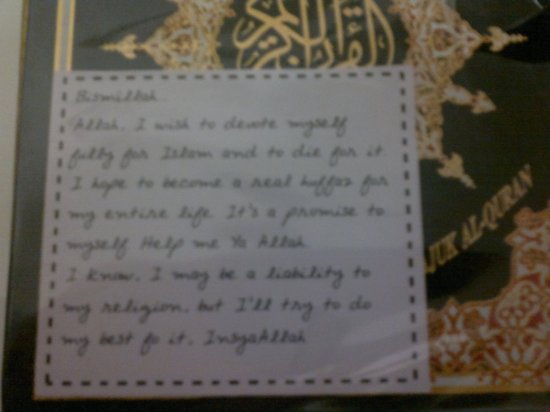
Quran yang aku gunakan sepanjang kehidupanku di DQ. Di atasnya ada kunukilkan azamku. Semoga azam itu kekal ternukil dalam kehidupanku, Amin.
Pesan ustaz tahfizku di SMIAA:
Sekali kamu hafal Quran, bermakna selama-lamanya kamu bertanggungjawab dan prlu berusaha untuk memelihara hafalan kamu.
Cebur apa-apa karier sekalipun, tak kisahlah sebagai doktor ke, architect ke, engineer ke, accountant ke, tapi, jadikanlah karier sebagai al-HAFIZ itu yang UTAMA. Kerna nanti di akhirat kelak, Allah bukan hendak melihat sijil ACCA ke apa ke, tapi, Allah akan melihat Quran yang kamu bawa, berserta peranan yang kamu mainkan sebagai huffaz.
Buat diriku (& mereka yang memilih untuk berada di jalan ini)…
Iadahlah, murajaahlah, mengulanglah, kerana ia telah ditaklifkan dan diwajibkan buat kita. Wajib, bermakna kita tidak punya pilihan untuk culas, malas, dsbnya.
Andai kita rasa lemah, yakinlah Allah menilai kita pada mujahadah. Hasil – kita ingat Quran ataupun tidak, itu Allah yang akan takdirkan. Perlu juga diingat, Allah tidak akan mengubah nasib sesuatu kaum itu sehingga mereka mengubahnya sendiri.
Alla the best Azlina. Allahu Yusahhiluki, Amin.
Hikmah & Hemah – Wajib bagi Pendakwah
May 27, 2011 at 9:15 am | Posted in Cetusan Pemikiran, Renungan | 1 CommentTags: daie. an-nahl, Hikmah dalam berdakwah, umar timilsani
Tersebutlah sebuah kisah di antara dua cucu Rasulullah, Saidina Hassan dan Hussin…
Alkisahnya begini, di suatu ketika, dua orang cucu Rasulullah yang amat tersohor lagi terbilang itu mengambil wudhu’ bersama-sama di suatu tempat. Ketika itu mereka masih kecil. Tiba-tiba, datang seseorang yang sudah berumur mengambil wudhu’ di kawasan yang sama. Nak dijadikan cerita, wudhu’ orang tua tersebut agak kurang sempurna. Hassan dan Hussin kebingungan memikirkan bagaimana harus ditegurnya perbuatan tersebut. Lalu mereka mengambil keputusan untuk bertanding wudhu’ siapakah yang paling sempurna, dengan menjadikan orang tua tersebut sebagai hakim. Akhirnya, orang tua tersebut perasan yang sebenarnya wudhu’ dialah yang tidak sempurna.
Sangat berhikmahkan Hassan dan Hussin menegur?
Tidak ada perasaan yang tersinggung, maruah yang tercalar, aib yang terbuka… Masing-masing dapat menerima dengan positif.
“Serulah manusia ke jalan tuhanmu dengan hikmah dan pelajaran yang baik…”
(An-Nahl:125)
Persoalan hikmah dan hemah ditekan dalam al-Quran, menunjukkan bahawa ia sangat dititik beratkan dalam Islam.
Dalam kita berdakwah, melaksanakan amar maaruf nahi munkar, sejauh mana hikmah dan hemah ini diaplikasikan dalam kehidupan kita? Kadang-kadang, sebagai generasi muda yang sangat kuat didorong oleh emosi serta semangat, bak kata orang tua-tua, berdarah panas, kita sering terlepas pandang persoalan adab ini. Umar at-Timilsani sering berpesan,
“Hikmah Asy-Syuyukh, fi hamasati As-Syabab”
yang bermaksud “Hikmah orang tua, berada dalam semangat orang muda.”
Kecenderungan untuk Merungut, Bukan Memulakan.
Status kawan-kawan aku kat FB ni merepek-repek. Tak membina langsung.
Daripada kita asyik merungut tanda tak meredhai perbuatan tersebut, mengapa tidak kita yang memulakan biah yang solehah (status yang islami, comment yang membina, chat benda yang bermanfaat buat umat) di FB kita?
Posting dalam blog (yang di share ramai-ramai) atau group FB ni merapu-rapu. Tak langsung menonjolkan keizzahan sebagai duat ataupun huffaz.
Daripada kita asyik mengomen tak habis-habis, mengapa tidak kita yang post benda-benda yang kita rasakan bermanfaat? Mengapa tidak kita yang mencetuskan?
Sematkanlah dalam diri kita, kalau kita lihat sesuatu yang tidak cocok di mata, kita yang perlu mengubahnya, bukan setakat merungut dan mengomen-ngomen di belakang. Kita yang perlu mulakan. TEGURAN DAN TINDAKAN PERLU SEIRING.
Kadang-kadang, kita lebih cenderung untuk menegur individu yang kita rasakan bersalah secara terang-terangan. Adakalanya teguran itu kasar bunyinya, tapi kita tidak perasan. Kita kurang berfikir tentang implikasi daripada tindakan yang kita lakukan. Kita sering menganggap semua orang “tidak ada perasaan”. Tidak dinafikan, teguran itu suatu keperluan, namun hikmah dan hemah itu satu kemestian. Sifat menghormati madu’ tidak boleh diketepikan. Perlu juga diingat, manusia itu fitrahnya amat menyukai kelembutan.
Daripada kita asyik mengatakan itu salah, ini tidak betul, yang ini lagha, “huffaz tak sepatutnya begitu”, “hampa ni dok mengaghot apa? ” lagi elok kalau kita yang tunjukkan caranya. Kita yang mulakan. Tunjukkan yang tak lagha tu bagaimana, yang tak mengarut tu macam mana. Be proactive. Madu’ yang ditegur akan faham sendiri, InsyaAllah.
Oh lagi satu, dalam kita menegur (terutamanya di blog dan chatbox, FB dan terang-terangan kita kenal siapa orangnya) tonjolkan sahaja identiti kita. Jangan berselindung di sebalik nama. InsyaAllah, kalau kita kenal siapa orang yang prihatin untuk membetulkan kita yang sudah terbengkok ini, izzah teguran itu lebih terasa. Kita juga lebih terasa bertanggungjawab dengan setiap patah kata yang kita nukilkan.
Duhai Daie, jangan sesekali kita memandang enteng isu hikmah ini. Penerimaan masyarakat terhadap dakwah kita sangat bergantung dengan cara kita menzahirkannya kepada mereka. Sekiranya kurang berhikmah, percayalah, diri daie dan apa yang disampaikannya akan terfitnah.
Sebab itulah Allah selalu menggunakan ungkapan “Inna Allaha ‘Alimun Hakim”. Tidak semua orang yang berilmu itu bijaksana.
Renungan bersama buat diri aku terutamanya…
p/s: Ini hanya pandangan, terbuka kepada perbincangan.
Of Tarbiyyah and “Baju”
May 25, 2011 at 7:46 pm | Posted in Cetusan Pemikiran, Renungan, Sekolahku | Leave a commentTags: Darul Quran, jemaah, Persijilan, SMI Al-Amin, Tarbiyyah
“Who is better in speech than one who calls men to Allah, work righteousness, and says, ‘verily, I am of those who are Muslims.”
[Fussilat : 33]
Tarbiyyah. According to Understanding Islam subject that we learnt through our three semesters in DQ, the root word for it is (Rabba, Yurabbi, Tarbiyyah) which means to cultivate, to nurture, to teach, etc.. etc.. (Haha, i’m really miss my sweet memory of learning UI in the SMN Audi)
When talking about tarbiyyah, I really remembered the moments in DQ where I began to understand the concept of it.
As an alumni of SMIAAG, people especially seniors in DQ do expect “something” from me. Sadly, I was not as what they expected. The “too condusive” environment in my beloved secondary school make me take the tarbiyyah that I received there for granted. Huhu, until now, I am still regret about this.
In DQ, I learnt that why we should choose a “baju” for us to wear in order for us to serve Islam. In my personal opinion, we should not read the idea of amal jamaie and only associate it with well-known jemaah like PAS, IKRAM, ISMA, HALUAN, and so on and start to label others who does not give wala’ or intima’ to any of those jemaah as ‘tak buat amal jamaie, tak bekerja untuk Islam‘. For me, amal jamaie is really flexible. If we devote ourselves to the society and do something regarding our deen, it is also can be considered as amal jamaie. Don’t label others as Allah is the only one who can judge us. As a muslim, we should choose the best type of amal jamaie that suite ourselves and with it, we can serve Islam the best.
In DQ, I learnt that there are many types of baju with different fashions and colours. At first glance, you will see that each of it is different from others. Actually, if we analyze it deeper, then we can see that all jemaah has the same objective, but the ways to achieve the objective are different. Hence, due to the differences in it, we tend to feel too proud (izzah) with our baju (in other word is taksub) and we become fanatic of our own baju. This situation is unhealthy. We should implement the concept of sinergy and salamatus sodri in this situation. In my own opinion, we should feel izzah towards our baju, but not taksub.
In DQ, I learnt that in order to choose the baju, we should choose the one that with it, we feel that we are closer to Allah. With it also, we can give the best for Islam. Choose the one that we think that the method of dakwah is based on Quran and Sunnah and is the closest to Sirah Nabawiyyah. Actually, it depends on how we view it. It’s our own ijtihad and our personal perception about truth. None of us can claim that their “baju” is the most true, most pure, etc..etc.. Later, Allah will choose who he wants to declare as the winner. The most important thing that we should do now is to try to strive our best for the ummah.
To all Akhawat DQ (diploma, sem 1, dan sem 3) good luck and try to strive harder in the future. If ‘they’ can do it, why we can’t? I’m really sorry because I realized that we should do some changes a bit late. Actually, it was very very late. I really hope for the changes to happen. InsyaAllah, my prayers will always there for you.
To others, I really hope that whatever happen after this, we can still manage our ukhuwwah well. Whatever baju we wear, we are still working for the same purpose. We are still being the architect of Islam. If we start to feel taksub with our baju, then remember, in the principle of ukhuwwah, which ithar as the highest degree of it, and salamatus sodri as the lowest level, we should not become selfish to think that ours is the best. Respect each other. Act islamically and professionally in facing the differences among us. Wallahu A’alam.
p/s: This is only my personal opinion. It is up to you, wheather to accept it or not.
Sayonara Darul Quran
May 22, 2011 at 8:10 pm | Posted in Citra Kehidupan, Renungan, Sekolahku | 1 CommentTags: Darul Quran JAKIM, DQ, Hafazan, IQRaC Gen 11, Persijilan, UIAM
20 Disember 2009
“Ya Allah, 18 bulan! Lamanya nak duduk Darul Quran ni… Tahan ke aku?”
“Ya Rabbi, ketatnya peraturan… Penjara ke apa? Outing sekali seminggu, minggu balik sekali sahaja sebulan..”
“Kalas Tasmi’ tiga jam. Maknanya mengaji tiga jam. Larat ke?”
“18 bulan=30 juz. Sehari=2 maqra’ tasmi’. Mampu ke? Iadah lagi…”
“Sahabat-sahabat aku bakal fly. Aku? Hemm…fly Kuala Kubu Baru lah jawabnya…”
Maka, bermulalah episod kehidupanku sebagai pelajar Darul Quran. Bermula dengan Minggu Haluan Siswa, Mafatihul Mahabbah, The Faith, LAFUNTA 2010 Interfame, MANTOP, The Glory, imtihan semester satu, Muhasabah sem, Ukhuwah Day, Forum When The Heart Whispers, Secret Admire, Nur Ramadhan, MITI, Hari Raya IQRaC,imtihan semester 2, LAFUNTA 2011, Tinta Daie, Interfame Gen 12, Futuwwah, MANTOP Gen 12, AGM, IIUM Voyage, sehinggalah Majlis Khatam dan The Prestige serta imtihan sem 3, daripada menjadi peserta sehinggalah menjadi KD program, sungguh, banyak input yang aku terima. Banyak tarbiah yang terselit di sebalik setiap satu yang telah Allah rencanakan buatku.
Dan setahun setengah yang awalnya kurasakan lama itu berlalu dengan begitu sekejap…
20 Mei 2011
Barang-barang keperluan hampir separuh sudah siap dikemas. Pagi itu kami berjalan-jalan di tasik Darul Quran. Menikmati pemandangan Darul Quran sambil mengenang nostalgia-nostalgia lalu.
“Sekejap je kan setahun setengah kat Darul Quran ni. Rasanya macam baru je semester 1, sekarang dah habis dah pun semester 3…”
“Haah… Sedih sangat. Anti, ana rasa sedih sangat nak tinggalkan DQ ni. Agak-agaknya nanti, bila kita dah besar, kat UIA ke, waktu dah berkeluarga dan berkerjaya ke, mesti kita akan kenang masa-masa kita di DQ ni kan? Ana takut sangat kalau satu hari nanti, kita akan kata kat diri kita, ‘Ya Allah, aku pernah hafal Quran ni. Tapi sekarang ni, tak ubah macam tilawah dah. Indah kan saat kita masyi Quran dulu…’ Nauzubillah, ana takut sangat Quran ni lari daripada ana. Ana takut sangat Allah lupakan hafazan Quran kita ini..”
“Tak apa, anti, Al-Quran itu milik Allah. Mujahadah dan mintalah padaNya. Mujahadah itu penting, Allah nilai pada mujahadah kita.“
“Ana ingat pesan US Dasuki pada ana waktu pergi jumpa minta maaf tadi. Us Dasuki pesan sangat-sangat supaya jaga al-Quran. Us kata, kalau kita mula meninggalkan hafazan al-Quran, akhlak dan peribadi kita benda pertama yang akan terjejas.. Nauzubillah~”
“Nanti kat UIA mesti kita dah tak rasa keadaan macam ini kan?”
“Sedih… Manis sangat biah kat DQ ni kan? 24 jam dengan al-Quran. Air mata kita, gembira kita, ketakutan kita, mujahadah kita, tension kita, stay up kita, semuanya ada kaitan dengan al-Quran. Susah dah nak cari masa macam ni dengan al-Quran.”
“Kat UIA nanti, macam mana ye kita nak balance kan contract sebagai hamba dan khalifah Allah, contract untuk iadah al-Quran, dengan tuntutan-tuntutan akademik yang menggunung? Itu baru soal belajar, belum lagi saat-saat kita mula bekerja, berkeluarga…”
“Al-wajibaat aksaru minal auqat, Hasan al-Banna kata.”
Kami sama-sama terdiam. Besar tanggungjawab kami selepas ini – memelihara hafazan al-Quran dan dalam masa yang sama, menterjemahkan al-Quran itu ke dalam seluruh aspek kehidupan.
Merenung kembali kehidupan aku selama setahun setengah di DQ, aku rasa aku akan rindu banyak benda. Ukhuwah yang sangat indah, biah yang sangat solehah, susah untuk aku cari di tempat-tempat lain.
Ukhuwah – ada benarnya ungkapan “ukhuwwah ikatan al-Quran itu lain rasanya”.
Biah solehah – masjid yang hanya beberapa tapak dari asrama, solat jemaah, irama ngaji 24/7, tazkirah asar, kelas tafaquh dan tibyan, usrah, sahabiah-sahabiah yang sentiasa mengingatkan, dan pelbagai lagi yang sukar kucoretkan.
Syukran buat kamu-kamu semua yang sudi hadir dalam hidupku! Kepada yang berterbangan di udara selepas ini, jangan lupakan kami yang di UIAM ini. Kepada yang ke Nilai nanti, selalulah jenguk kami yang di PJ ni. Jangan lupa bawa cenderamata dari Nilai Square tau! Siiru ala Barakatillah.
Semoga kita semua kekal thabat dalam tarbiah di mana sahaja kita berada! Strive for the best in whatever we do. Daie mesti cemerlang! Be a balance person. Islam itu wasatiyyah.
Syafawi Sem 3
May 16, 2011 at 4:14 pm | Posted in Citra Kehidupan, Imtihan, Sekolahku | Leave a commentTags: Darul Quran, IQRaC Gen 11, Syafawi
Alhamdulillah… Alhamdulillah… Alhamdulillah…
Setelah puas berhari-hari jadi “separuh manusia”, beruzlah kebanyakan masa, akhirnya, imtihan syafawi sem tiga yang ditakuti oleh majoriti ahli-ahli IQRaC (Intellectual Quranic Generation Club) telah aku lalui. Dilalui dengan jayanya atau tidak, itu bukan persoalannya. Bagiku, yang manis untuk dikenang ialah mujahadah dan usaha di sebalik imtihan tersebut.
Menyebut mengenai usaha, bagiku, mujahadah mengulang untuk imtihan kali ini adalah sangat manis untuk dikenang. Kehangatan ukhuwwah itu benar-benar terasa saat ada yang memberi semangat tatkala aku “down”, kejut tatkala tersyahid, menggembirakan tatkala sedang tertekan yang amat, mengingatkan tatkala aku diserang wabak malas, dan pelbagai lagi support yang tak mampu untuk kurakamkan. Syukran semua!
16 Mei 2011
Maktabah DQ
p/s:
Alhamdulillah, offer letter dah boleh download. Tetapkan hati dan pendirianku Ya Allah…
Create a free website or blog at WordPress.com.
Entries and comments feeds.
